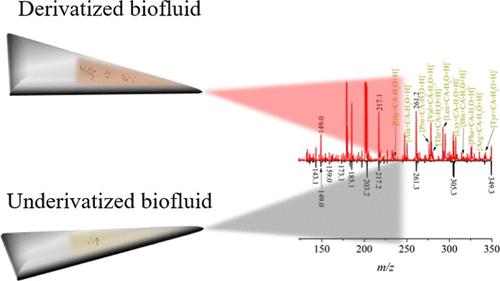当前位置:
X-MOL 学术
›
Anal. Chem.
›
论文详情
Our official English website, www.x-mol.net, welcomes your feedback! (Note: you will need to create a separate account there.)
Enhanced Compound Analysis Using Reactive Paper Spray Mass Spectrometry: Leveraging Schiff Base Reaction for Amino Acid Detection
Analytical Chemistry ( IF 7.4 ) Pub Date : 2024-03-20 , DOI: 10.1021/acs.analchem.4c00215 Marcos Bouza 1 , Daniel Foest 2 , Sebastian Brandt 2 , Juan F. García-Reyes 1 , Joachim Franzke 2
Analytical Chemistry ( IF 7.4 ) Pub Date : 2024-03-20 , DOI: 10.1021/acs.analchem.4c00215 Marcos Bouza 1 , Daniel Foest 2 , Sebastian Brandt 2 , Juan F. García-Reyes 1 , Joachim Franzke 2
Affiliation

|
Paper spray mass spectrometry (PS-MS) has evolved into a promising tool for monitoring reactions in thin films and microdroplets, known as reactive PS, alongside its established role in ambient and direct ionization. This study addresses the need for rapid, cost-effective methods to improve analyte identification in biofluids by leveraging reactive PS-MS in clinical chemistry environments. The technique has proven effective in derivatizing target analytes, altering hydrophobicity to enhance elution and ionization efficiency, and refining detection through thin-film reactions on paper, significantly expediting reaction rates by using amino acids (AAs) as model analytes. These molecules are prone to interacting with substrates like paper, impeding elution and detection. Additionally, highly abundant species in biofluids, such as lipids, often suppress AA ionization. This study employs the Schiff base (SB) reaction utilizing aromatic aldehydes for AA derivatization to optimize reaction conditions time, temperature, and catalyst presence and dramatically increasing the conversion ratio (CR) of formed SB. For instance, using leucine as a model AA, the CR surged from 57% at room temperature to 89% at 70 °C, with added pyridine during and after 7.5 min, displaying a 43% CR compared to the bulk reaction. Evaluation of various aromatic aldehydes as derivatization agents highlighted the importance of specific oxygen substituents for achieving higher conversion rates. Furthermore, diverse derivatization agents unveiled unique fragmentation pathways, aiding in-depth annotation of the target analyte. Successfully applied to quantify AAs in human and rat plasma, this reactive PS-MS approach showcases promising potential in efficiently detecting conventionally challenging compounds in PS-MS analysis.
中文翻译:

使用反应纸喷雾质谱法增强化合物分析:利用席夫碱反应进行氨基酸检测
纸喷雾质谱 (PS-MS) 已发展成为一种有前途的监测薄膜和微滴反应的工具,称为反应性 PS,同时它在环境电离和直接电离中也发挥着既定的作用。本研究满足了对快速、经济有效的方法的需求,通过在临床化学环境中利用反应性 PS-MS 来改进生物流体中的分析物识别。事实证明,该技术可有效衍生目标分析物、改变疏水性以提高洗脱和电离效率,以及通过纸上薄膜反应改进检测,通过使用氨基酸 (AA) 作为模型分析物显着加快反应速率。这些分子容易与纸张等基材相互作用,阻碍洗脱和检测。此外,生物体液中高度丰富的物质(例如脂质)通常会抑制 AA 电离。本研究采用席夫碱 (SB) 反应,利用芳香醛进行 AA 衍生化,以优化反应条件、时间、温度和催化剂的存在,并显着提高所形成的 SB 的转化率 (CR)。例如,使用亮氨酸作为 AA 模型,CR 从室温下的 57% 飙升至 70 °C 下的 89%,在 7.5 分钟期间和之后添加吡啶,与本体反应相比,CR 为 43%。对各种芳香醛作为衍生剂的评估强调了特定氧取代基对于实现更高转化率的重要性。此外,不同的衍生剂揭示了独特的裂解途径,有助于对目标分析物进行深入注释。这种反应性 PS-MS 方法成功应用于定量人类和大鼠血浆中的 AA,展示了在 PS-MS 分析中有效检测传统挑战性化合物的巨大潜力。
更新日期:2024-03-20
中文翻译:

使用反应纸喷雾质谱法增强化合物分析:利用席夫碱反应进行氨基酸检测
纸喷雾质谱 (PS-MS) 已发展成为一种有前途的监测薄膜和微滴反应的工具,称为反应性 PS,同时它在环境电离和直接电离中也发挥着既定的作用。本研究满足了对快速、经济有效的方法的需求,通过在临床化学环境中利用反应性 PS-MS 来改进生物流体中的分析物识别。事实证明,该技术可有效衍生目标分析物、改变疏水性以提高洗脱和电离效率,以及通过纸上薄膜反应改进检测,通过使用氨基酸 (AA) 作为模型分析物显着加快反应速率。这些分子容易与纸张等基材相互作用,阻碍洗脱和检测。此外,生物体液中高度丰富的物质(例如脂质)通常会抑制 AA 电离。本研究采用席夫碱 (SB) 反应,利用芳香醛进行 AA 衍生化,以优化反应条件、时间、温度和催化剂的存在,并显着提高所形成的 SB 的转化率 (CR)。例如,使用亮氨酸作为 AA 模型,CR 从室温下的 57% 飙升至 70 °C 下的 89%,在 7.5 分钟期间和之后添加吡啶,与本体反应相比,CR 为 43%。对各种芳香醛作为衍生剂的评估强调了特定氧取代基对于实现更高转化率的重要性。此外,不同的衍生剂揭示了独特的裂解途径,有助于对目标分析物进行深入注释。这种反应性 PS-MS 方法成功应用于定量人类和大鼠血浆中的 AA,展示了在 PS-MS 分析中有效检测传统挑战性化合物的巨大潜力。



























 京公网安备 11010802027423号
京公网安备 11010802027423号